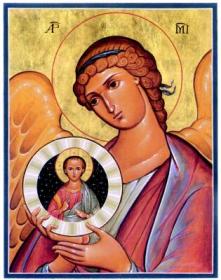 With oil from the lampada that burned before this holy icon, St. Seraphim would anoint the sick and they would be healed. He was praying in front of this icon when he died on 2 January 1833. After his death, the abbot gave the holy icon to the sisters of the monastery at Diveyevo. The icon is sometimes known as the Seraphim-Diveyevo icon of the Theotokos, after the convent where it now resides.
With oil from the lampada that burned before this holy icon, St. Seraphim would anoint the sick and they would be healed. He was praying in front of this icon when he died on 2 January 1833. After his death, the abbot gave the holy icon to the sisters of the monastery at Diveyevo. The icon is sometimes known as the Seraphim-Diveyevo icon of the Theotokos, after the convent where it now resides. While searching on-line for an icon of St. Seraphim to use with my post, I frequently encountered a very different icon of the Theotokos that was said incorrectly to be this icon of St. Seraphim's. One might think that a particular icon that is often depicted in the icons of a popular saint, and which is still in existence in a known location, would be immune to problems of mistaken identity. But in thinking this, one would be seriously underestimating the Orthodox penchant for uncritically believing and repeating misinformation.
While searching on-line for an icon of St. Seraphim to use with my post, I frequently encountered a very different icon of the Theotokos that was said incorrectly to be this icon of St. Seraphim's. One might think that a particular icon that is often depicted in the icons of a popular saint, and which is still in existence in a known location, would be immune to problems of mistaken identity. But in thinking this, one would be seriously underestimating the Orthodox penchant for uncritically believing and repeating misinformation.This beautiful icon is of the Eleousa type. While Eleousa is sometimes translated, like Umilenie, as "Tenderness," more strictly it means "Merciful." I would conjecture that someone, reading that St. Serphim's icon was of the "Tenderness" type found the most beautiful "Tenderness" icon he could find and assumed St. Seraphim's must be similar. This surprisingly popular misidentification has been appearing in some pretty authoritative places on-line, such as the Website of the Orthodox Church in America (here). But the OCA displays the very same icon here, where it is labeled as the Mother of God of the Pskov Caves Monastery. I think this latter identification is probably correct – I have seen it in other places, as well.
Meanwhile, the only other image of Our Lady I have seen that is similar to St. Seraphim's Umilenie is the wonder-working image of Our Lady of Ostrobrama, which resides in Vilnius, Lithuania, where it is venerated by Catholics and Orthodox alike.


10 comments:
Thank You! St. Seraphem is my patron saint, but I've not been able to find the icon of the Virgin Mary he used. Oddly enough, the icon I used of The Virgin is Our Lady of Tenderness, but it does have her with Christ.
Thanks, Roland. Where did you find the topmost image? That one is really drawing me.
Kevin,
You can find it here. And the second one is here.
The Akathist of Thanksgiving site has around 100 different icons of the Theotokos. Unfortunately, many of them are labeled incorrectly and matched to incorrect descriptions, so don't believe everything you read there.
Some other especially nice ones from the site are Czestochowa, Sayadnaya, Novgorod, Chernigov, Valaam, Kazan, and Mariapoch.
Thanks Roland! I think I'd like to have a copy made of that one.
If you are ever at St. John the Baptist Russian Orthodox Cathedral in Washington, DC, look for a copy of St. Seraphim's Umilenie icon next to the north door, which leads to the parish hall.
As I started to read this post, a very sweet, comforting aroma appeared between the monitor and my nose. It was almost like the smell of a Russian cross fashioned out of pine and incense. I'm wondering if there are any miraculous scents associated with Saint Seraphim. (I know modern Catholic saints Padre Pio and Therese have perfume and roses, respectively.)
I was not able to find any association of St. Seraphim with any scent. But he spent many years living as a hermit in the woods, and in his icons (like this and this) he is often depicted with pine trees.
Roland, I love your blog, it is so beautiful and this post on the Joy of All Joys is very moving. Well done. I like your taste in music also, The Who, The Beatles, Bruce Cockburn and others. I have linked to your blog. Blessings, Byzantine Christian.
http://byzantinechristian.blogspot.com
Thanks Roland! Now, would you have a way of finding out what the prayer St. Seraphim offered that was 'like the Rosary'?
I'm glad I read the comments. I loved the whole Seraphim/pine trees discussion. The Greek Orthodox rosary is a very powerful experience, along with "Lord Jesus Christ, Son of God, save me, the sinner", and it is as follows:
Rejoice, O Virgin Mother of God,
Mary full of grace,
the Lord is with thee!
Blessed art thou amongst women,
and blessed is the fruit of thy womb,
for thou hast born the Savior of our souls.
Θεοτόκε Παρθένε,
χαίρε κεχαριτωμένη Μαρία,
ο Κύριος μετά σου.
Ευλογημένη συ εν γυναιξί,
και ευλογημένος ο καρπός της κοιλίας σου,
ότι Σωτήρα έτεκες των ψυχών ημών
Post a Comment